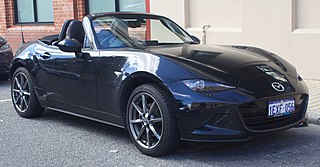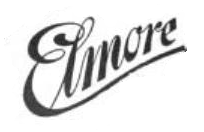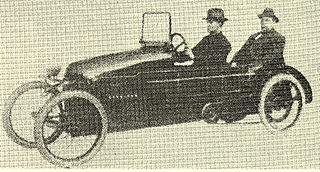A classic car is an older automobile, typically 20 years or older, though definitions vary. The common theme is of an older car of sufficient historical interest to be collectable and worth preserving or restoring rather than scrapping.
Automotive engineering, along with aerospace engineering and naval architecture, is a branch of vehicle engineering, incorporating elements of mechanical, electrical, electronic, software, and safety engineering as applied to the design, manufacture and operation of motorcycles, automobiles, and trucks and their respective engineering subsystems. It also includes modification of vehicles. Manufacturing domain deals with the creation and assembling the whole parts of automobiles is also included in it. The automotive engineering field is research -intensive and involves direct application of mathematical models and formulas. The study of automotive engineering is to design, develop, fabricate, and test vehicles or vehicle components from the concept stage to production stage. Production, development, and manufacturing are the three major functions in this field.

A roadster is an open two-seat car with emphasis on sporting appearance or character. Initially an American term for a two-seat car with no weather protection, usage has spread internationally and has evolved to include two-seat convertibles.

A suicide door is the slang term for an automobile door hinged at its rear rather than the front. Such doors were originally used on horse-drawn carriages, but are rarely found on modern vehicles, primarily because they are perceived as being less safe than a front-hinged door.

Front-wheel drive (FWD) is a form of engine and transmission layout used in motor vehicles, where the engine drives the front wheels only. Most modern front-wheel-drive vehicles feature a transverse engine, rather than the conventional longitudinal engine arrangement generally found in rear-wheel-drive and four-wheel drive vehicles.

The Muntz Car Company was an automobile manufacturer based in the United States.

Motobécane was a French manufacturer of bicycles, mopeds, motorcycles, and other small vehicles, established in 1923. "Motobécane" is a compound of "moto", short for motorcycle; "bécane" is slang for "bike."

Elmore Manufacturing Company was a manufacturer of veteran and brass era automobiles and bicycles (1893–97), headquartered at 504 Amanda Street, Clyde, Ohio, from 1893 until 1912. The company took its name from its original place of manufacture, the nearby village of Elmore. Founded by Harmon Von Vechten Becker and his two sons, James and Burton, the Elmore used a two-stroke engine design, in straight twin or single-cylinder versions. They later produced a straight-3 as well.

Automotive design is the process of developing the appearance, and to some extent the ergonomics, of motor vehicles, including automobiles, motorcycles, trucks, buses, coaches, and vans.

Lists of automobile-related articles cover a wide range of topics related to cars. The lists are organized by manufacturer, region, sport, technology and so on.

Dongfeng Honda Automobile Co., Ltd. is an automobile manufacturing company headquartered in Wuhan, China, and a 50:50 joint-venture between Dongfeng Motor Group and Honda Motor Company. It currently produces a variety of Honda models also available in other markets and a handful of China-only products. The company sells vehicles under the Honda and Ciimo marques.

Columbia was an American brand of automobiles produced by a group of companies in the United States. They included the Pope Manufacturing Company of Hartford, Connecticut, the Electric Vehicle Company, and an entity of brief existence in 1899, the Columbia Automobile Company.

The Otomo was a Japanese automobile built by Mr. Hayataya Toyokawa from 1924 to 1927 at the Hakuyosha Ironworks in Tokyo. It was meant to build upon his experimental Ales cars of 1921. Otomo offered an air-cooled 944 cc four-cylinder light car, available as two- or four-seat tourer or saloon (sedan), or as a van. This was joined in 1926 by a water-cooled 24 hp model. During this time, Otomo was one of only two Japanese automakers, joined by the Japanese established Gorham Automobile Company, financed by American aircraft engineer William R. Gorham. The remnants of the Gorham Automobile Company became the Nissan Motor Company Ltd. The car found it difficult to compete with Ford Model T's being manufactured at Yokohama, and Chevrolet Capitols being built at Osaka, and the company was integrated with other smaller Japanese automobile manufacturers. The 1923 Great Kantō earthquake also disrupted the local economy, with manufacturing resources greatly affecting business operations.

The Xenia was an American cyclecar designed by P. E. Hawkins of Cleveland and manufactured in Xenia, Ohio in 1914. The factory was Fred Baldner's machine shop, in which Baldner manufactured his own car from 1900 to 1903.

A car is a wheeled motor vehicle used for transportation. Most definitions of cars say that they run primarily on roads, seat one to eight people, have four tires, and mainly transport people rather than goods.

The automotive industry in the United States began in the 1890s and, as a result of the size of the domestic market and the use of mass production, rapidly evolved into the largest in the world. However, the United States was overtaken as the largest automobile producer by Japan in the 1980s, and subsequently by China in 2008. The U.S. is currently second among the largest manufacturer in the world by volume, with approximately 8-10 million manufactured annually. Notable exceptions were 5.7 million automobiles manufactured in 2009, and peak production levels of 13-15 million units during the 1970s and early 2000s.
The Drivotrainer was an automobile driving simulator promoted by the Aetna Insurance Company and widely used in driver training classes.

Rennzweier is a veteran automobile manufactured by Nesselsdorfer Wagenbau-Fabriks-Gesellschaft A.G. in 1900. It is sometimes also called First racing, 12 HP or Rennwagen. It was commissioned by baron Theodor von Liebig. Hans Ledwinka, the man behind the famous rear-engined Tatras, and at the time only 20 years old, took part in constructing the car. The car was manufactured on May 5, 1900, and the manufacturing process took only 5 weeks.

The Präsident was an automobile manufactured by Nesselsdorfer Wagenbau-Fabriks-Gesellschaft A.G. in 1897. It was the first actually drivable factory made petrol-engined automobile produced in Austria-Hungary as well as in Central and Eastern Europe. It was constructed by Leopold Sviták and Hans Ledwinka. The automobile was more of a carriage without horses than a car in modern sense. The car is steered via handlebars. The wooden bodywork is placed on an iron frame. It has four seats and a convertible top that would cover only the rear seats. Both axles have suspension of semi-elliptical leaf springs. The wheels were similar to the ones of a horse carriage, but had rubber tyres. The car had a two cylinder spark ignition Benz engine placed by the rear axle.

Société Parisienne was a French manufacturer of velocipedes, bicycles and tricycles from 1876. They began limited automobile construction in 1894 and regular light car (voiturette) construction in 1898 or 1899, and they ceased operation in 1903. The vehicles, variously known as Parisienne, Victoria Combination, Eureka, l'Eclair, Duc-Spider and Duc-Tonneau, were manufactured by Société Parisienne E. Couturier et Cie of Paris.















